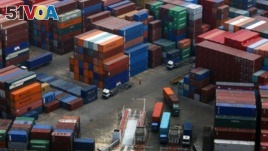Vitality in many sectors of the U.S. economy depends increasingly on engagement and opportunities in the growing Asia-Pacific region.
“Only by committing ourselves in the long term to the Asia-Pacific region will we be able to promote successfully the economic prosperity of the United States," said Under Secretary for Economic Growth, Energy, and the Environment Robert Hormats at the Asia Society Global Forum in Washington, D.C.
The United States believes that the countries of the Asia-Pacific region can get more done, and do it more effectively, if they work together and supports strengthening of Asia-Pacific regional institutions. For example, by working with our partners through the Asia Pacific Economic Cooperation, or APEC, the region’s premier forum for economic cooperation, we have succeeded in lowering tariffs on environmental goods and services, worked toward instituting market-based, non-discriminatory innovation policies, and encouraged greater participation by women in APEC economies.
The United States is also working with the Association of South East Asian Nations, or ASEAN, to further ASEAN’s goal of an integrated economic community in South East Asia by2013
Vitality in many sectors of the U.S. economy depends increasingly on engagement and opportunities in the growing Asia-Pacific region.
“Only by committing ourselves in the long term to the Asia-Pacific region will we be able to promote successfully the economic prosperity of the United States," said Under Secretary for Economic Growth, Energy, and the Environment Robert Hormats at the Asia Society Global Forum in Washington, D. C.

Trucks transport cargo at a container terminal in the port of Dalian, China. (file)
The United States believes that the countries of the Asia-Pacific region can get more done, and do it more effectively, if they work together and supports strengthening of Asia-Pacific regional institutions. For example, by working with our partners through the Asia Pacific Economic Cooperation, or APEC, the region’s premier forum for economic cooperation, we have succeeded in lowering tariffs on environmental goods and services, worked toward instituting market-based, non-discriminatory innovation policies, and encouraged greater participation by women in APEC economies.
The United States is also working with the Association of South East Asian Nations, or ASEAN, to further ASEAN’s goal of an integrated economic community in South East Asia by 2015.
Through both APEC and ASEAN, the United States is supporting capacity building programs in the critical energy sector; helping to boost the interconnectivity, and the development of natural gas, renewable energy and sustainable energy sources.
Nonetheless, our highest trade priority, is a successful completion of negotiations by the end of this year, of the Trans-Pacific Partnership, [or TPP], a key component of our economic policy in the Asia-Pacific region, said Under Secretary Hormats. “The TPP is intended to be a far-reaching trade agreement that brings together some of the largest and fastest growing economies of the Pacific Rim. . . . Through the TPP, the United States is pursuing a rules-based and high-standard regional economic and trade architecture,” he said.
“U.S. commitment to the Asia-Pacific region is not one for the mere short term,” said Under Secretary Hormats. “The U.S. government looks forward to forging closer multilateral and bilateral partnerships with the Asia-Pacific region not just this year, or the next, but in the long term as well.”